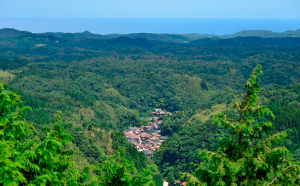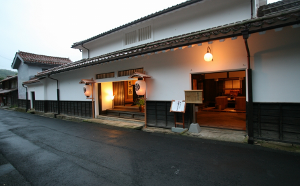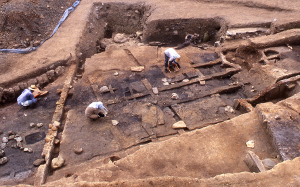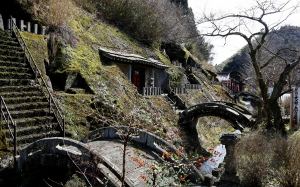Omori Village Itinerary






Itinerary Type :
Architecture,
Autumn Colors Viewing,
Hiking/Walks,
Historic Sites,
Industrial Sites,
Museums,
Temples/Shrines
The Iwami Ginzan UNESCO World Heritage Site consists of 14 component sites. The two main gateways to the area are from Matsue, the capital of Shimane Prefecture, which takes 80-105 minutes, and from Hiroshima which takes 110-130 minutes. The majority of the sites are most easily seen by car. The Omori Village on the other hand is best seen by parking at the central parking area and walking between the sites in the village. Note that there are 2 bicycle rental shops in town that you may want to use: Kawamura Bicycle Rental Shop at MapCode: 599 144 061*41, and Yashichi Bicycle Rental Shop at MapCode: 599 113 326*55. Both shops have a few parking spaces.
Omori Village (Omori-cho or Omori-machi) is an historic small village in the heart of the Iwami Ginzan Silver Mine area (1526-1923). There is an approximately 1.5 km/1 mi long main street with historic buildings, shops, museums, shrines, temple, accommodations, etc. As there isn't room to park along the street it is best to park at this central parking area (Iwami Ginzan Public Parking Lot, MapCode: 599 113 262*85) and walk around the town. Normally a visitor will enter from the east end of town (MapCode: 599 144 274*71) and drive to the parking lot. Keep in mind that this is an actual town so be respectful of people's privacy and property. Starting at the east end of the village some of the notable sites are:
The Miyanomae Refinery Ruins was built between the end of the 16th century and the beginning of the 17th century. It was discovered near the Daikansho (Iwami Ginzan Museum) Site in the Omori Zone. There are only archeological remains today. (MapCode: 599 144 367*74)
The The Kigami Shrine can be considered the spiritual anchor of Omori. The shrine was established in its current location in 1577, when the ruling Mori family had it built to protect the town and its residents from misfortune. The sanctuary, along with much of the rest of Omori, was destroyed in a great fire in 1800 and then rebuilt 12 years later. The current buildings date back to this reconstruction and include an imposing two-story worship hall (haiden) with a distinctive hip-and-gable roof. Part of the hall is decorated with the family emblems of samurai who made donations to the shrine, but the most impressive feature of its interior is arguably the nakiryu (“roaring dragon”). This ceiling mural from 1818 represents a dragon in flight and, thanks to some ingenious acoustics, “roars” if you clap your hands while standing directly underneath it. (MapCode: 599 144 303*52)
The Iwami Ginzan Museum originally was the office of the local representative of the shogun . (MapCode: )
The Kumagai Family Residence belonged to the Kumagai family, who for centuries were the richest and most influential in Omori. They began expanding their authority in the early 1600s, after the silver mine and the lands surrounding it were seized by the Tokugawa shogunate, which was to rule Japan until 1867. The family made its fortune in mining but later diversified to include financial and contracting services for the magistrate’s office, which represented the central government in the region. At least since 1718 a member of the Kumagai family was the official tasked with weighing silver to determine its purity and collecting payments from miners whose product was found lacking in quality. This function was a crucial part of the government’s taxation activities, so the Kumagai family were well compensated for performing it. The buildings were used as a residence until the end of the 20th century and then restored to resemble its appearance in 1868. The residence gives visitors a sense of how an affluent merchant family lived when Iwami Ginzan was at the height of its prosperity. (MapCode: 599 143 119*71)
The Arata Barbershop is a traditional 20th century Japanese barbershop. (MapCode: 599 143 057*58)
The . (MapCode: )
The . (MapCode: )
The . (MapCode: )
The town of Omori has functioned as the administrative and commercial hub of Iwami Ginzan since the early 1600s. This was when the Tokugawa clan, which by 1603 had vanquished most of its rival warlords and founded the shogunate that was to rule Japan until 1867, established an office for its magistrate in charge of local affairs at the foot of the mountain. A town sprang up around the magistrate’s office, with merchants and samurai moving in to satisfy the office’s demand for goods and services. This created further employment opportunities, and the town’s population continued to increase.
Diverse Townscape
Omori’s relatively small area and sudden development resulted in a peculiarly mixed urban structure, with the houses of samurai, tradespeople, and commoners, along with shrines and temples, intermingling in close proximity. This was a rarity in feudal Japan, where the social classes usually lived in separate neighborhoods. Although most of the town was destroyed in a fire in 1800, this patchwork distribution of land remains the distinguishing feature of Omori. Walking through the town, you will see that the former samurai residences have gardens between the houses and the street, whereas most shops and multiple-unit dwellings front on the thoroughfare. In the Edo period (1603–1867), gardens were a sign of status, but they could also be used for practical purposes: some of the samurai households built small structures in the gardens and rented them to bring in additional income.
Red Tiles and Plum Trees
Omori is also known for the red tiles used on many of the town’s roofs. Made from the iron-rich clay found in the area, these sekishu-kawara (“Sekishu tiles”; Sekishu is another name for the Iwami area) are common throughout the Chugoku region, where Shimane Prefecture is located. Looking out over the town from above, you will notice that many of the larger buildings have gray roofs. Such structures tend to be traditional samurai residences or administrative facilities; gray tiles were favored by the warrior class as a symbol of authority. Another visual feature of the town is its ume plum trees, many of which were planted when the silver mine was still active. Miners believed that the citric acid in pickled plums would help them stay alert in the dusty shafts, so they would stick these fruit inside their masks when they entered the mines.
Visiting Omori Today
Although the town of Omori has been designated a historic district and is protected from development, some of the old buildings have been put to innovative uses. A good example is Gungendo, a shop, cafe, and gallery housed in a renovated Edo-period farmhouse, where you can purchase clothing and local food, view artwork, and sit down for lunch or a snack while gazing at the garden.
Omori is a historic town that is happy to welcome visitors as long as its residents’ privacy and way of life are respected. Please refrain from entering homes or taking pictures of the residents without permission.
Omori Village (Omori-cho or Omori-machi) is an historic small village in the heart of the Iwami Ginzan Silver Mine area (1526-1923). There is an approximately 1.5 km/1 mi long main street with historic buildings, shops, museums, shrines, temple, accommodations, etc. As there isn't room to park along the street it is best to park at this central parking area (Iwami Ginzan Public Parking Lot, MapCode: 599 113 262*85) and walk around the town. Normally a visitor will enter from the east end of town (MapCode: 599 144 274*71) and drive to the parking lot. Keep in mind that this is an actual town so be respectful of people's privacy and property. Starting at the east end of the village some of the notable sites are:
The Miyanomae Refinery Ruins was built between the end of the 16th century and the beginning of the 17th century. It was discovered near the Daikansho (Iwami Ginzan Museum) Site in the Omori Zone. There are only archeological remains today. (MapCode: 599 144 367*74)
The The Kigami Shrine can be considered the spiritual anchor of Omori. The shrine was established in its current location in 1577, when the ruling Mori family had it built to protect the town and its residents from misfortune. The sanctuary, along with much of the rest of Omori, was destroyed in a great fire in 1800 and then rebuilt 12 years later. The current buildings date back to this reconstruction and include an imposing two-story worship hall (haiden) with a distinctive hip-and-gable roof. Part of the hall is decorated with the family emblems of samurai who made donations to the shrine, but the most impressive feature of its interior is arguably the nakiryu (“roaring dragon”). This ceiling mural from 1818 represents a dragon in flight and, thanks to some ingenious acoustics, “roars” if you clap your hands while standing directly underneath it. (MapCode: 599 144 303*52)
The Iwami Ginzan Museum originally was the office of the local representative of the shogun . (MapCode: )
The Kumagai Family Residence belonged to the Kumagai family, who for centuries were the richest and most influential in Omori. They began expanding their authority in the early 1600s, after the silver mine and the lands surrounding it were seized by the Tokugawa shogunate, which was to rule Japan until 1867. The family made its fortune in mining but later diversified to include financial and contracting services for the magistrate’s office, which represented the central government in the region. At least since 1718 a member of the Kumagai family was the official tasked with weighing silver to determine its purity and collecting payments from miners whose product was found lacking in quality. This function was a crucial part of the government’s taxation activities, so the Kumagai family were well compensated for performing it. The buildings were used as a residence until the end of the 20th century and then restored to resemble its appearance in 1868. The residence gives visitors a sense of how an affluent merchant family lived when Iwami Ginzan was at the height of its prosperity. (MapCode: 599 143 119*71)
The Arata Barbershop is a traditional 20th century Japanese barbershop. (MapCode: 599 143 057*58)
The . (MapCode: )
The . (MapCode: )
The . (MapCode: )
The town of Omori has functioned as the administrative and commercial hub of Iwami Ginzan since the early 1600s. This was when the Tokugawa clan, which by 1603 had vanquished most of its rival warlords and founded the shogunate that was to rule Japan until 1867, established an office for its magistrate in charge of local affairs at the foot of the mountain. A town sprang up around the magistrate’s office, with merchants and samurai moving in to satisfy the office’s demand for goods and services. This created further employment opportunities, and the town’s population continued to increase.
Diverse Townscape
Omori’s relatively small area and sudden development resulted in a peculiarly mixed urban structure, with the houses of samurai, tradespeople, and commoners, along with shrines and temples, intermingling in close proximity. This was a rarity in feudal Japan, where the social classes usually lived in separate neighborhoods. Although most of the town was destroyed in a fire in 1800, this patchwork distribution of land remains the distinguishing feature of Omori. Walking through the town, you will see that the former samurai residences have gardens between the houses and the street, whereas most shops and multiple-unit dwellings front on the thoroughfare. In the Edo period (1603–1867), gardens were a sign of status, but they could also be used for practical purposes: some of the samurai households built small structures in the gardens and rented them to bring in additional income.
Red Tiles and Plum Trees
Omori is also known for the red tiles used on many of the town’s roofs. Made from the iron-rich clay found in the area, these sekishu-kawara (“Sekishu tiles”; Sekishu is another name for the Iwami area) are common throughout the Chugoku region, where Shimane Prefecture is located. Looking out over the town from above, you will notice that many of the larger buildings have gray roofs. Such structures tend to be traditional samurai residences or administrative facilities; gray tiles were favored by the warrior class as a symbol of authority. Another visual feature of the town is its ume plum trees, many of which were planted when the silver mine was still active. Miners believed that the citric acid in pickled plums would help them stay alert in the dusty shafts, so they would stick these fruit inside their masks when they entered the mines.
Visiting Omori Today
Although the town of Omori has been designated a historic district and is protected from development, some of the old buildings have been put to innovative uses. A good example is Gungendo, a shop, cafe, and gallery housed in a renovated Edo-period farmhouse, where you can purchase clothing and local food, view artwork, and sit down for lunch or a snack while gazing at the garden.
Omori is a historic town that is happy to welcome visitors as long as its residents’ privacy and way of life are respected. Please refrain from entering homes or taking pictures of the residents without permission.